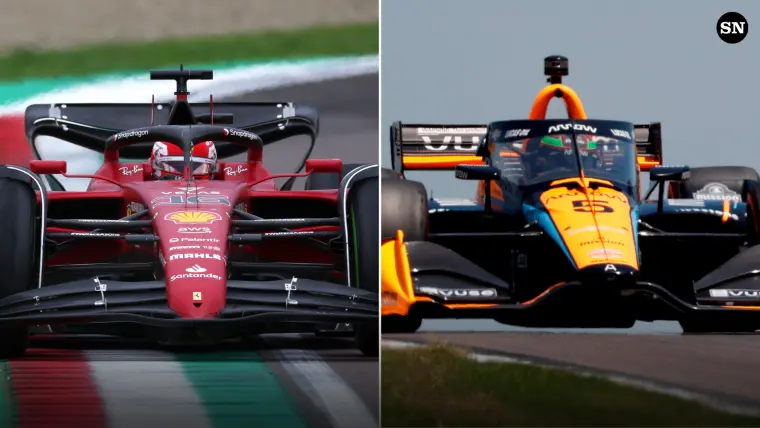Now that the F1 2024 schedule is coming to an end and with IndyCar still in its preseason, let’s dive into a very important topic: Formula 1 vs IndyCar. These two disciplines are incredibly similar, and fans can’t stop debating which one is better, which has the best cars, and the most exciting drivers.
But first, a bit of historical context.
History
Formula 1
Formula 1 officially began as an organization in 1950 and has been regulated by the FIA (Fédération Internationale de l’Automobile) ever since. However, its roots trace back to the 1920s and 1930s, inspired by the Grand Prix races of Europe. From that point on, Formula 1 has shown relentless ambition to evolve technologically, innovating year after year.
- Founded: 1950
- Regulating Body: FIA
- Driver with the Most Championship Wins: Tie (7) between Michael Schumacher and Lewis Hamilton
- Most Successful Team: Ferrari, with 16 Constructors’ Championships
IndyCar
IndyCar is the premier single-seater racing category in the United States. Like many American sports, it draws inspiration from early 1900s auto racing. It upholds iconic traditions, most notably the Indianapolis 500, a race so legendary that drivers from all disciplines aspire to compete in it—just as Fernando Alonso and Juan Pablo Montoya, both renowned Formula 1 drivers, have done.
This discipline is more traditional, focusing less on cutting-edge technology and more on discovering and showcasing top driving talent. Many Formula 1 drivers transition to IndyCar during their careers, highlighting its appeal and competitive spirit.
- Founded: Roots trace back to 1911
- Regulating Body: INDYCAR LLC
- Driver with the Most Championship Wins: A.J. Foyt with 7 championships
- Most Successful Team: Team Penske with 19 driver championships
Car Configuration
One of the main differences lies in the configuration of the cars. In Formula 1, each team is required to build its own chassis and key components based on its resources and engineering capabilities. Additionally, F1 cars have significantly higher aerodynamic downforce.
In contrast, IndyCar follows a more standardized setup. All teams use the same Dallara chassis, with only two engine options: Honda or Chevrolet. IndyCar cars have less aerodynamic downforce, as they need to be adapted for both road courses and oval tracks.
F1 cars are powered by 1.6-liter V6 hybrid engines, while IndyCar uses 2.2-liter V6 engines.
Tracks and Competition
There are some notable differences in this area. Formula 1 races exclusively on road and street circuits throughout the year. Meanwhile, IndyCar competes on two types of tracks: road courses and ovals.
When it comes to drivers, both series showcase immense talent. However, the standardization in IndyCar allows for greater parity among competitors, often resulting in multiple winners during a season. In F1, this is less common, as the performance of a driver is heavily influenced by the quality of their car. Formula 1 teams with superior engineering enable their drivers to dominate the F1 standings.
Some drivers who didn’t find success in Formula 1 have transitioned to IndyCar. Notable examples include Romain Grosjean and Marcus Ericsson, both former F1 drivers now competing in IndyCar. On the flip side, Pato O’Ward is one of the few IndyCar drivers with a potential path to Formula 1, currently serving as a reserve driver for McLaren.
How Fast Are Formula 1 Cars vs IndyCars?
This is perhaps the most attention-grabbing difference. It’s important to understand that both disciplines have unique needs. The IndyCar season includes several oval tracks, which significantly influence the configuration of their cars, while the Formula 1 calendar focuses on tracks dominated by tight corners and technical layouts.
To make a fair comparison, it’s necessary to break it down into different scenarios:
Top Speed
- IndyCar: 378–386 km/h (235–240 mph)
- Formula 1: 362–370 km/h (225–230 mph)
0–100 km/h (0–62 mph) Acceleration
- Formula 1: 2.7 seconds
- IndyCar: 3 seconds
While IndyCars are faster in a straight line, Formula 1 cars excel in cornering speed thanks to their superior aerodynamic downforce.
For example, at the 2019 Circuit of the Americas test:
- The best-performing IndyCar completed a lap in 1:46.018 with an average speed of 186.349 km/h (115.79 mph).
- Meanwhile, Valtteri Bottas’s Formula 1 car clocked 1:32.029 with an average speed of 206.374 km/h (128.27 mph).
The significant difference lies in how each car handles corners, with F1 cars being much faster due to their design.
Closing Thoughts
Throughout history, it’s clear that both disciplines share many characteristics while excelling in their own unique ways. With Formula 1’s recent expansion into the U.S. market, the future of motorsport racing promises to be thrilling.
Oh, and yes, we forgot about NASCAR—our apologies!
For more information on this fascinating discipline, subscribe to our F1 newsletter!
